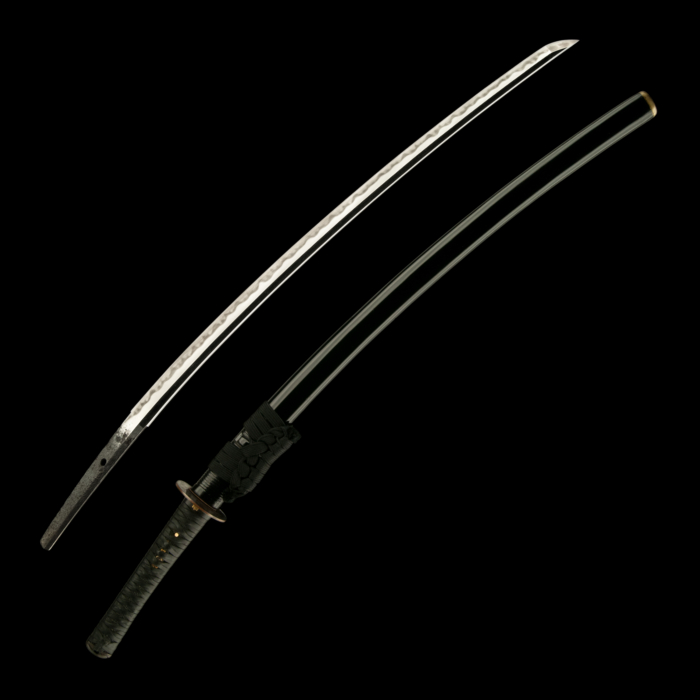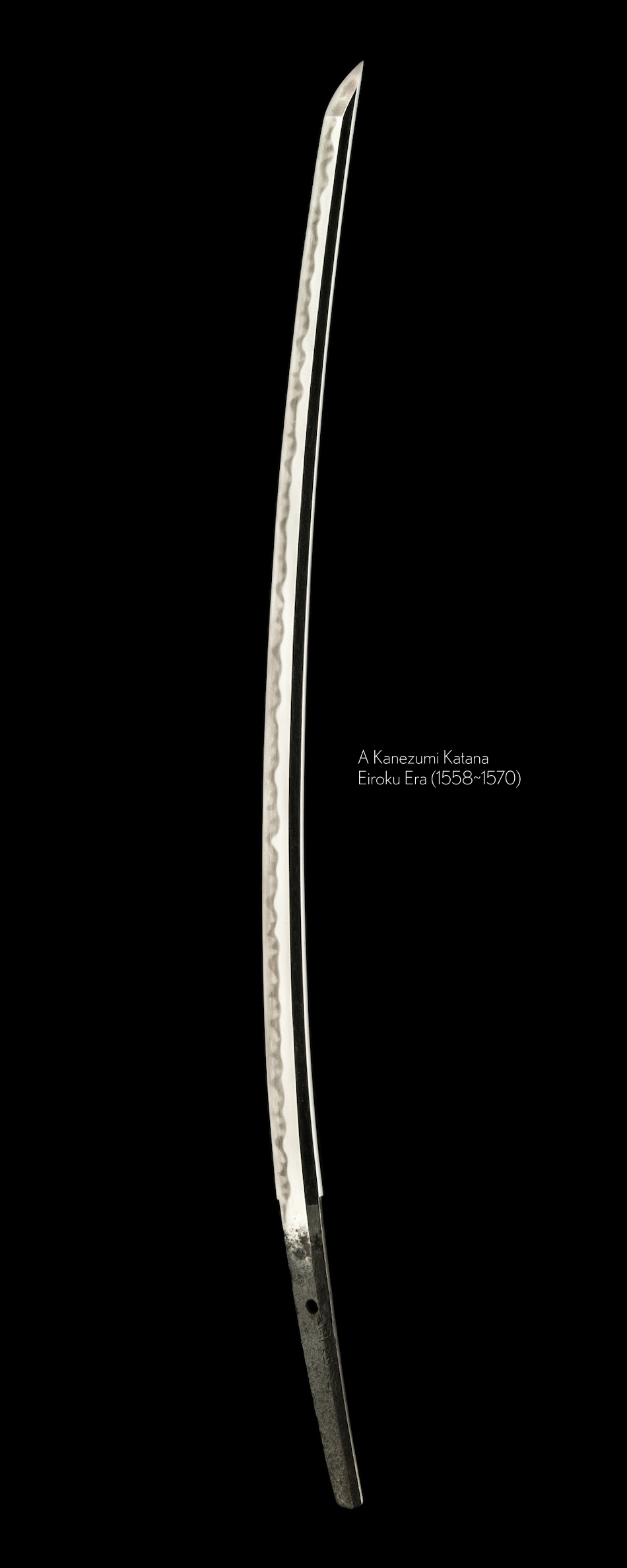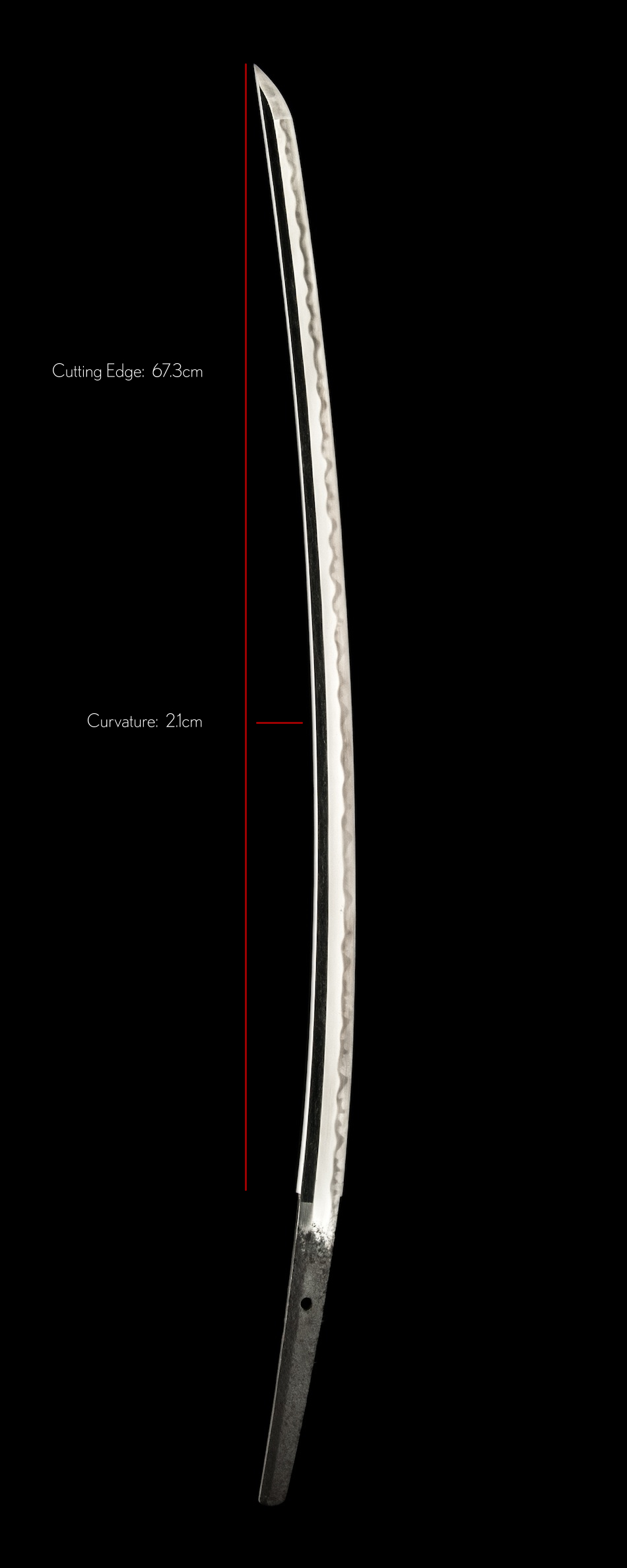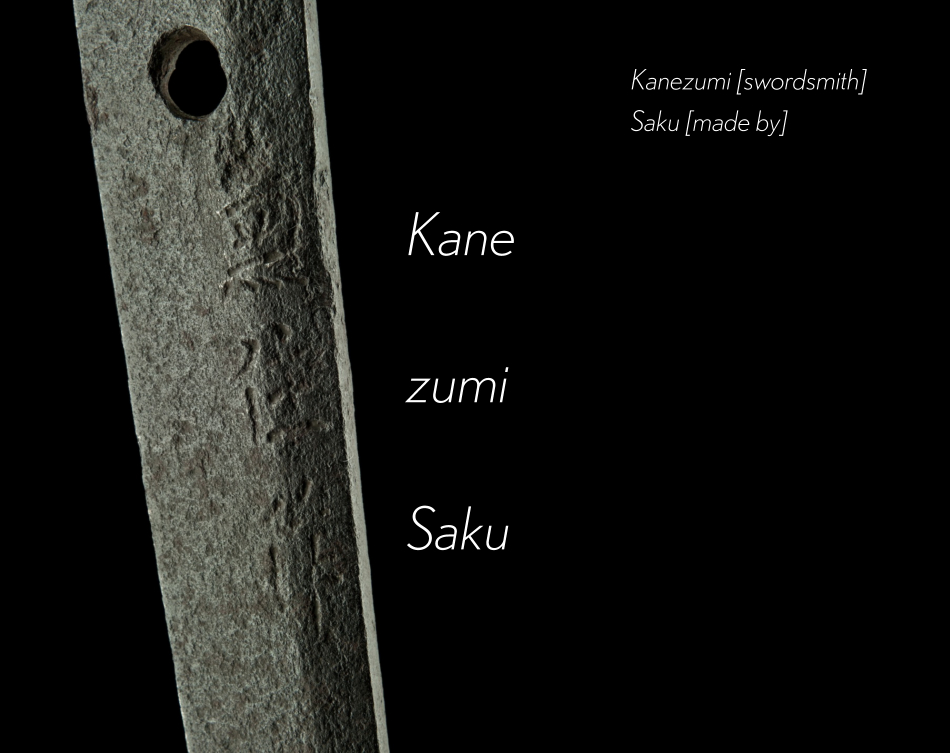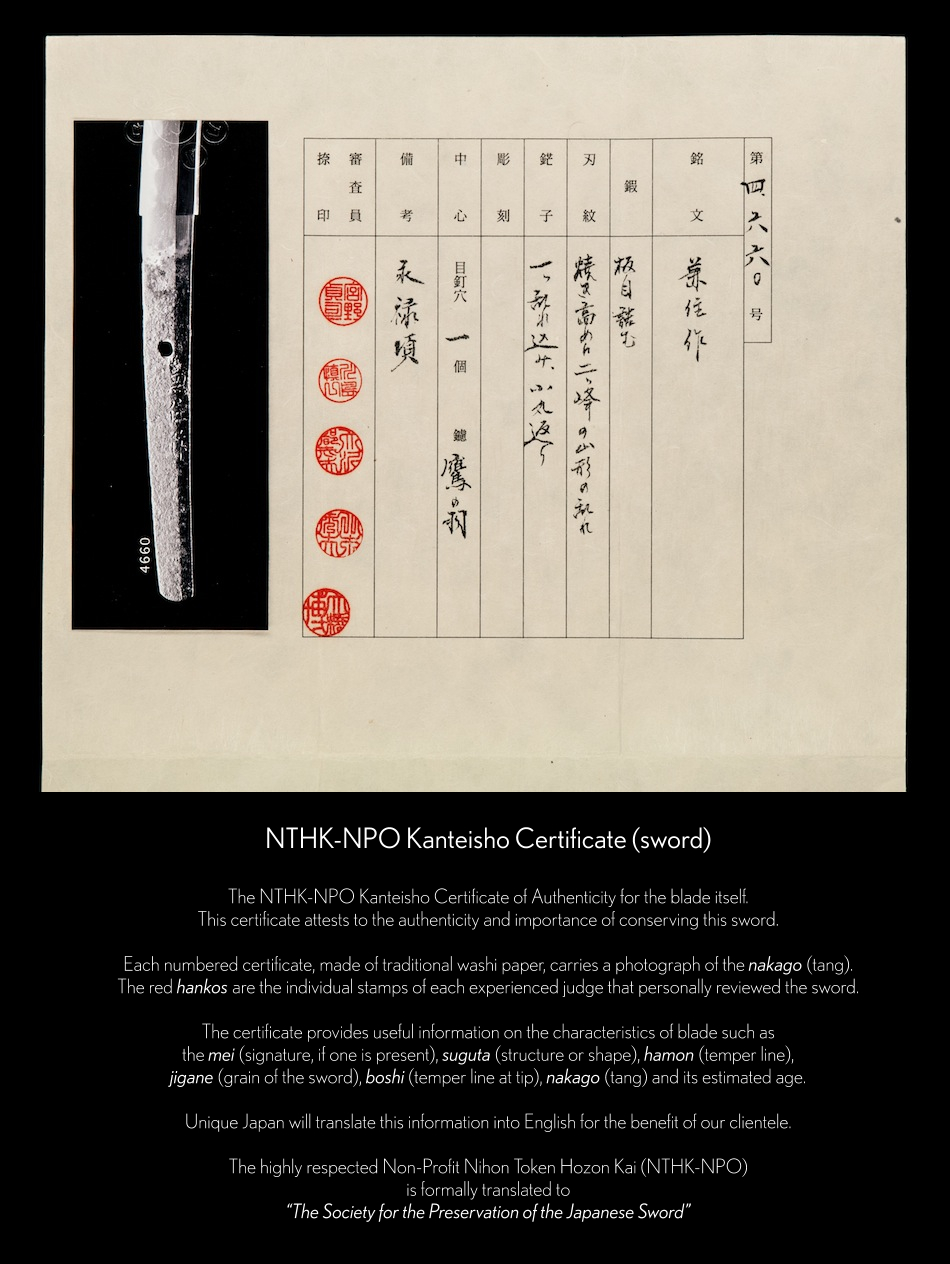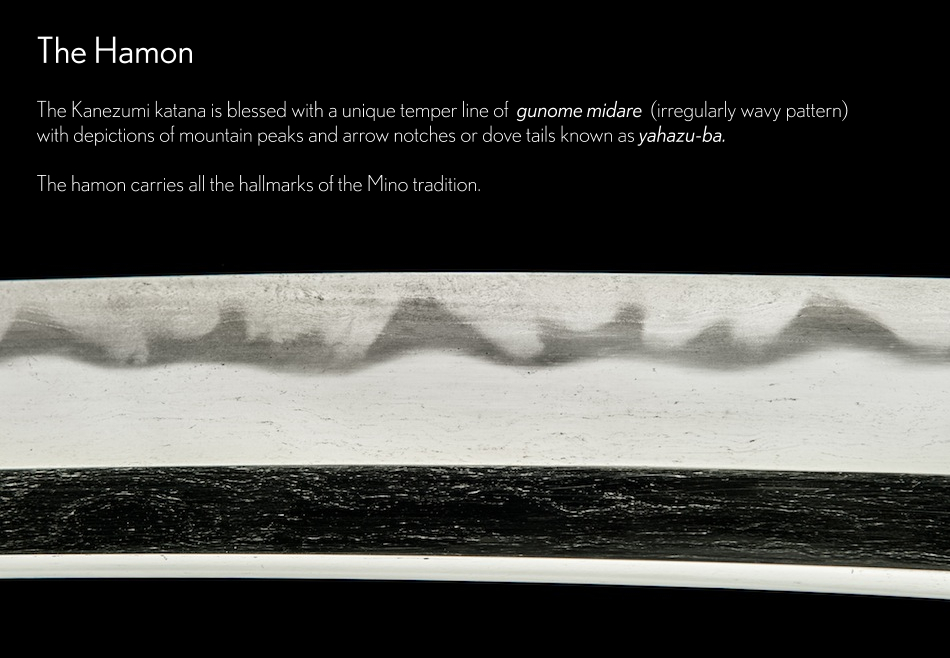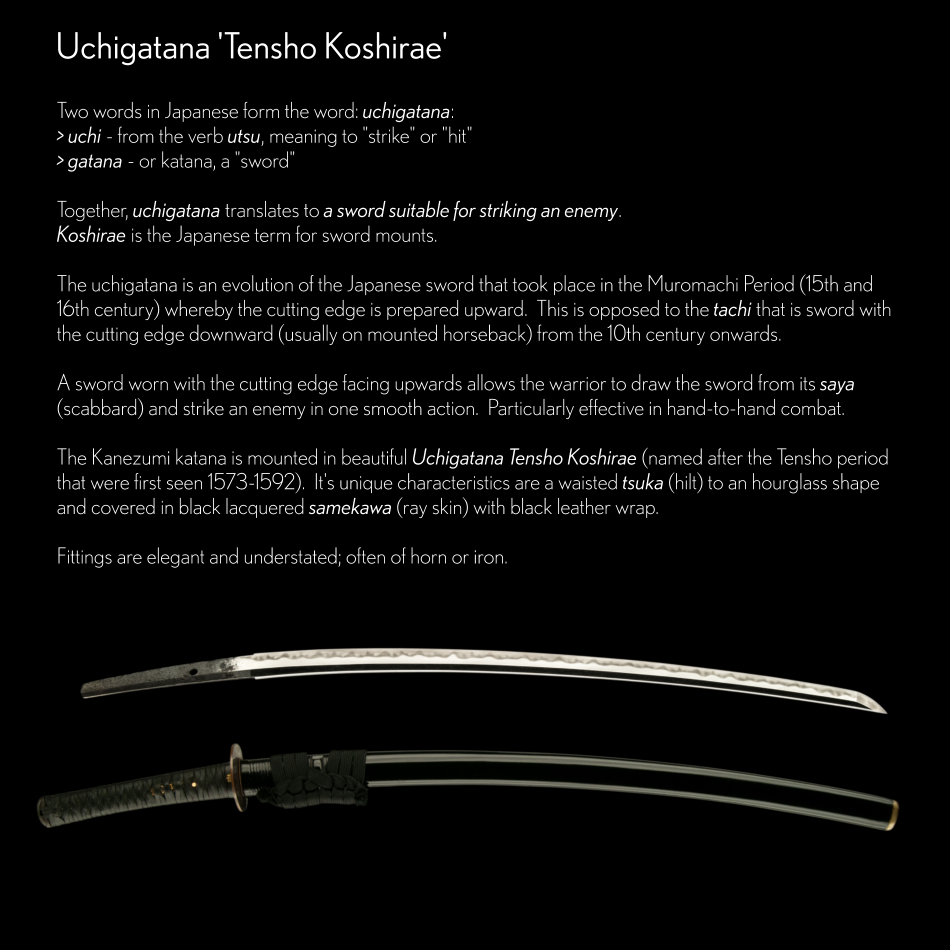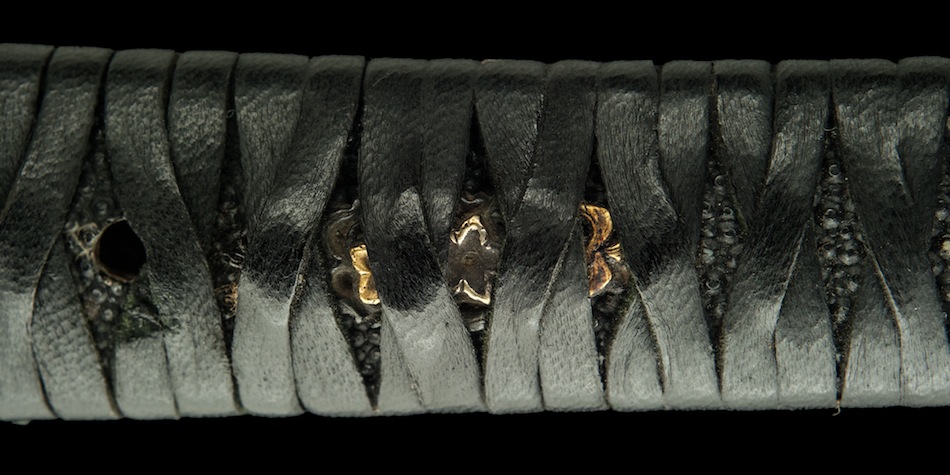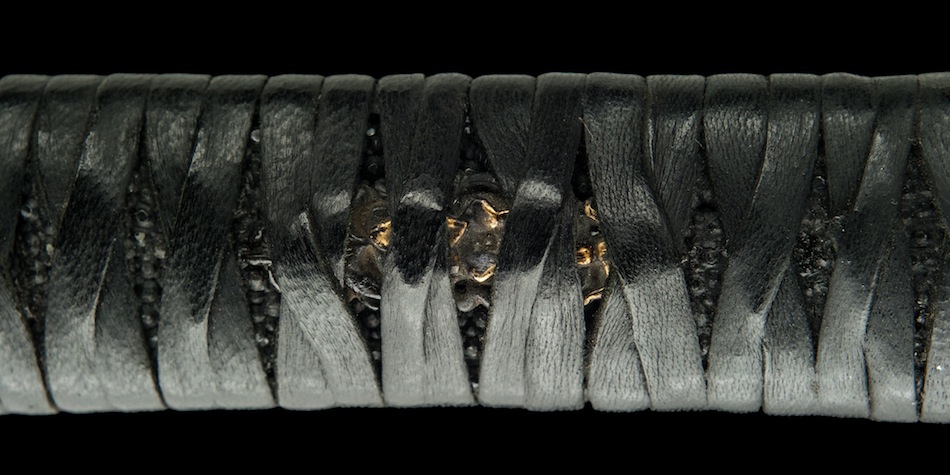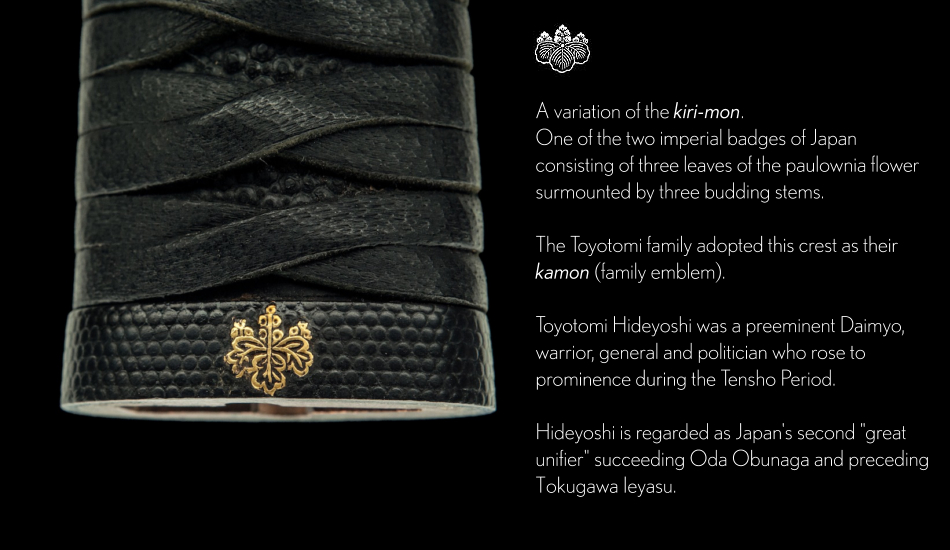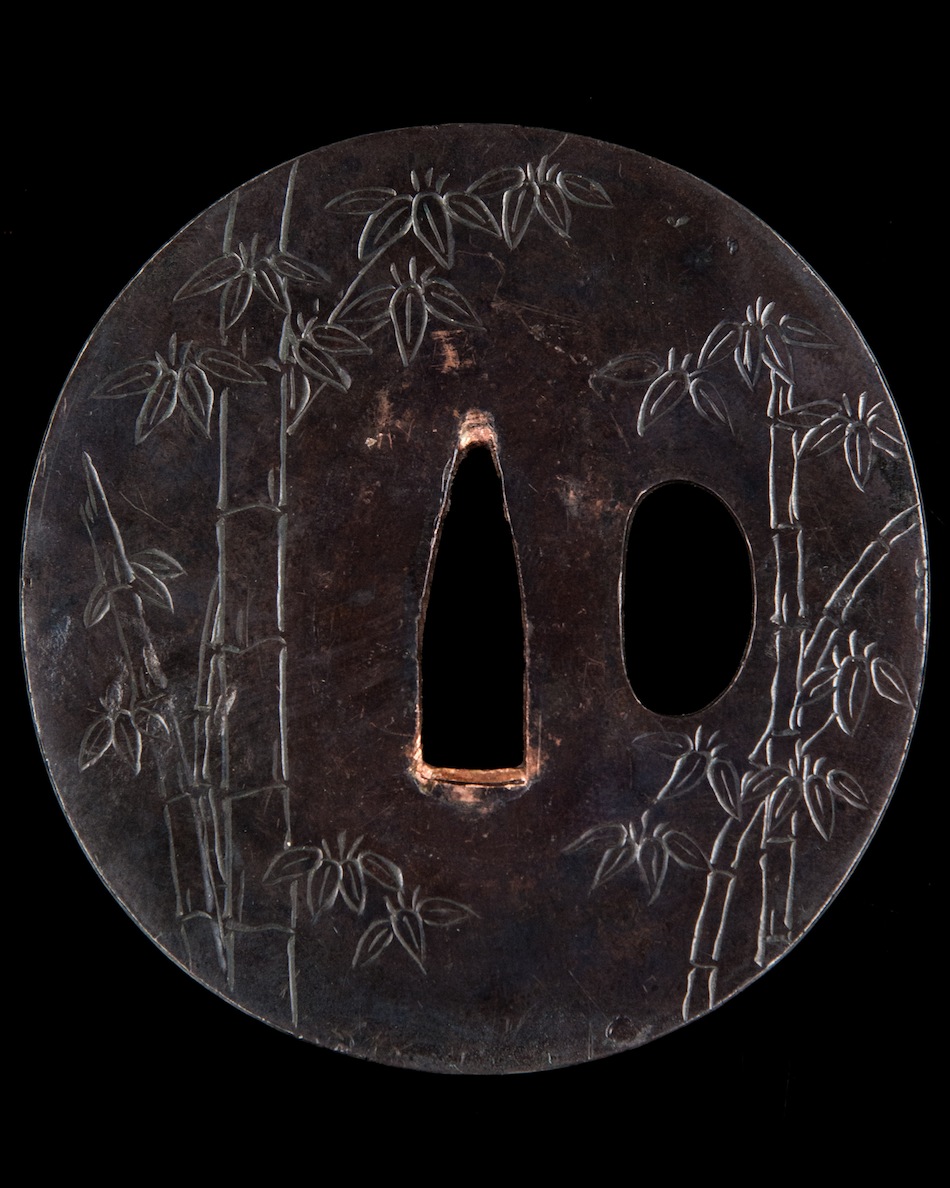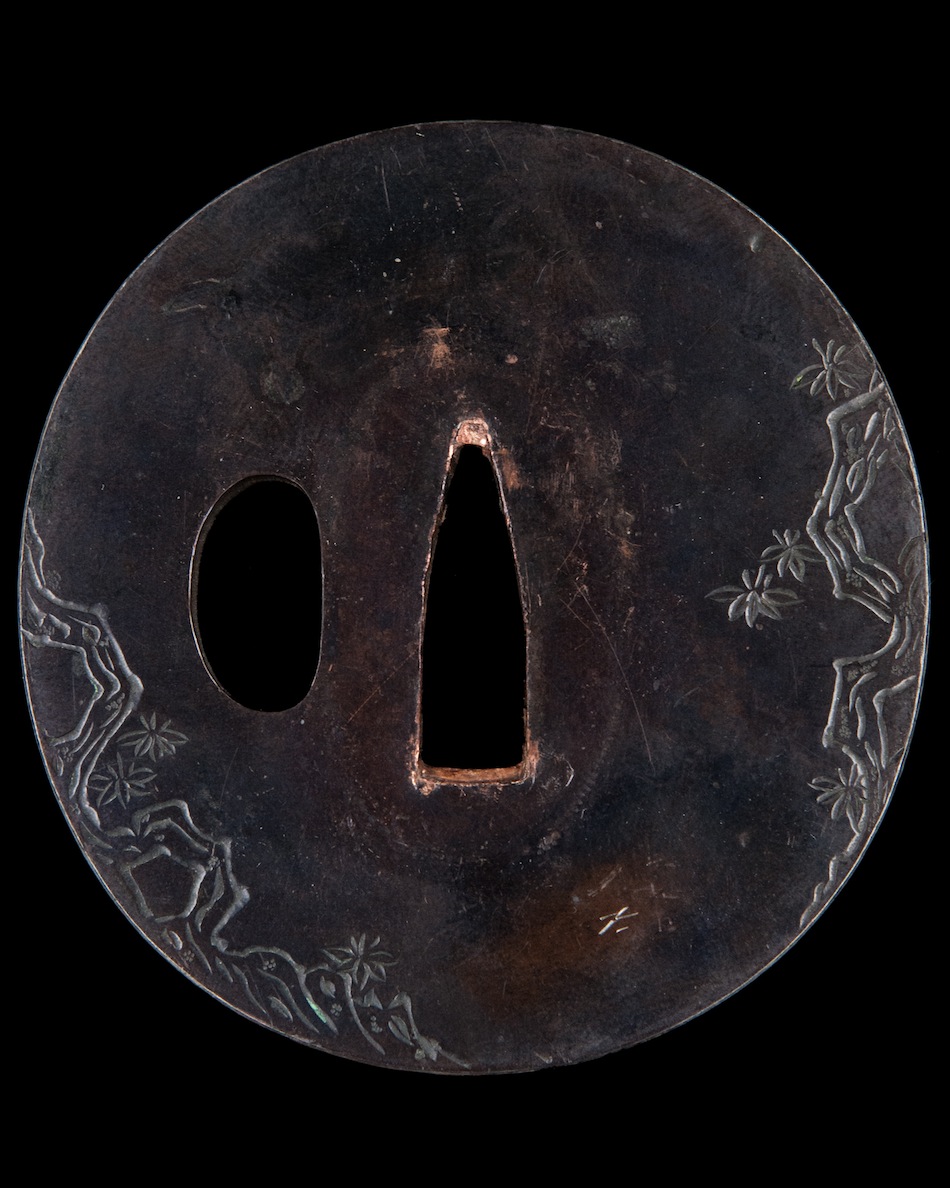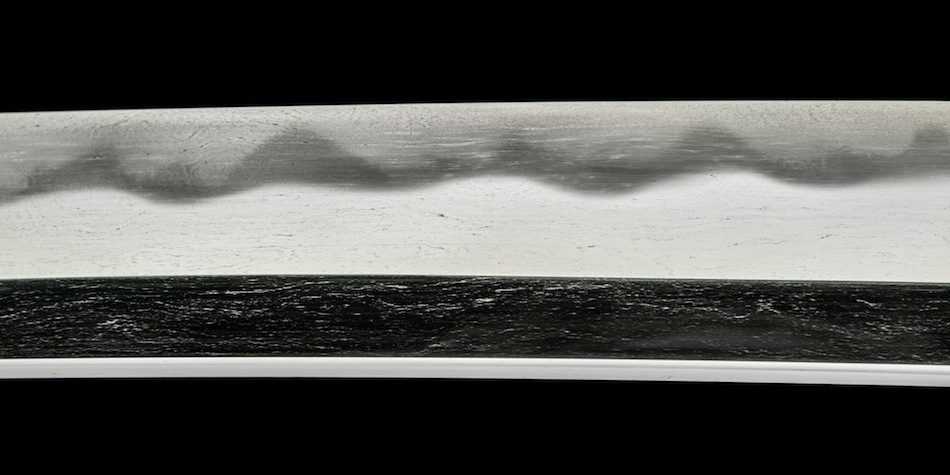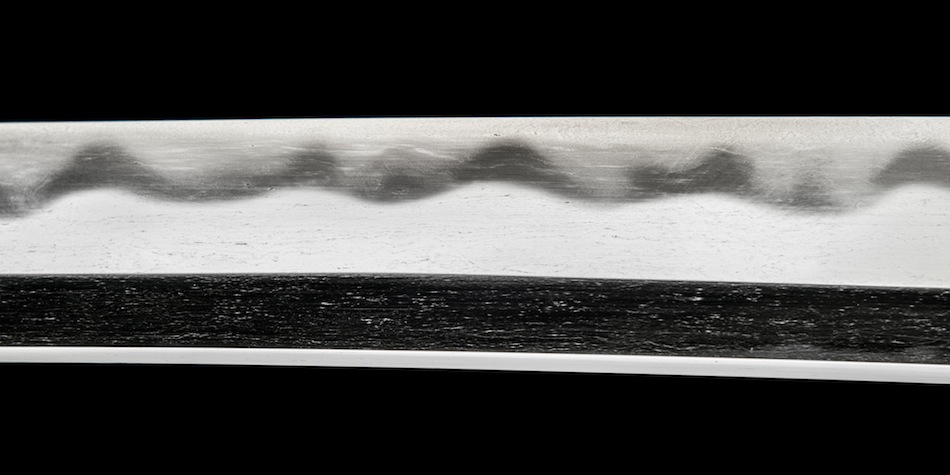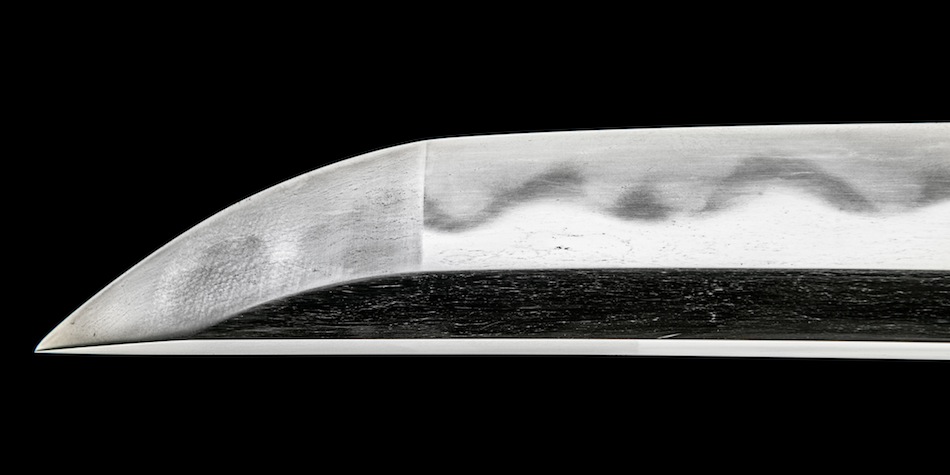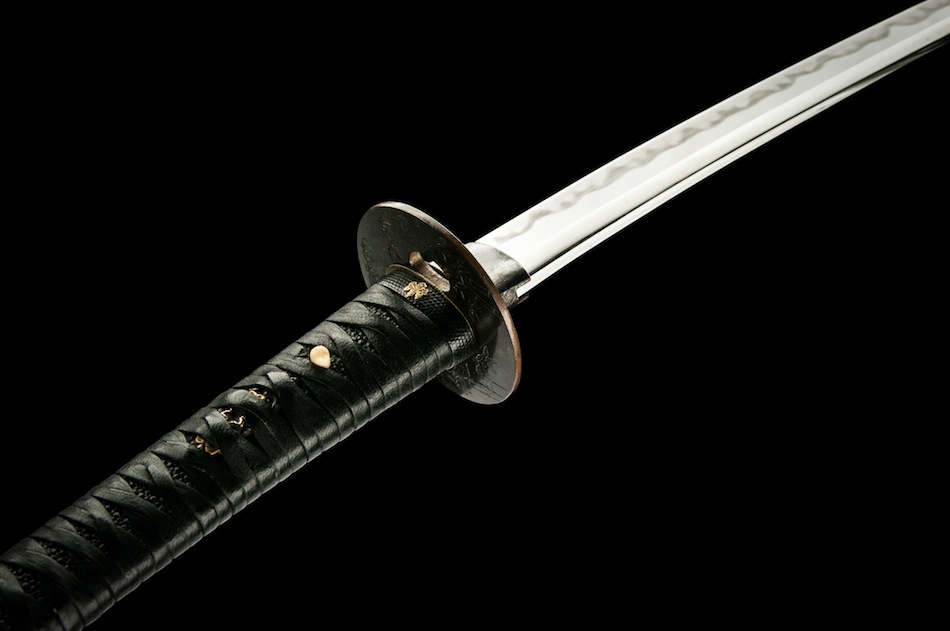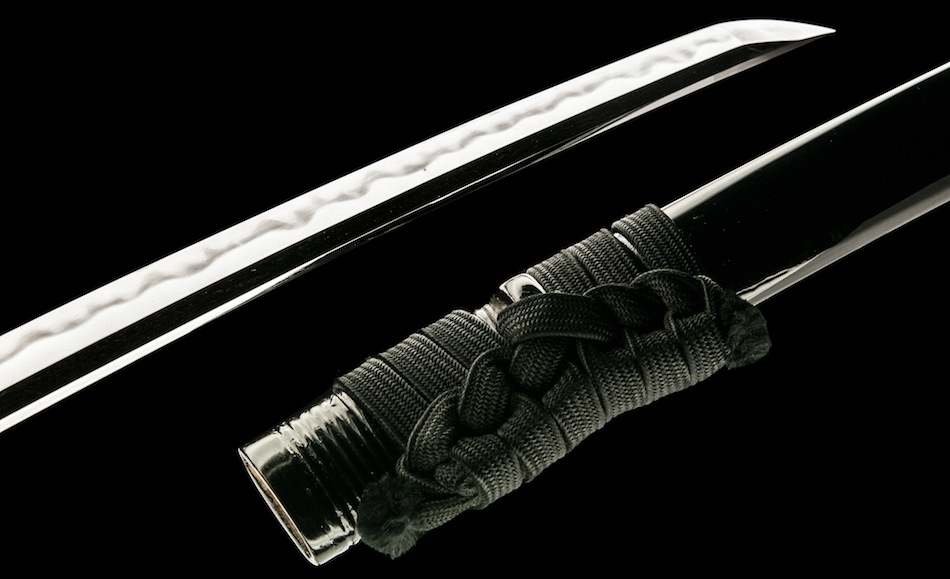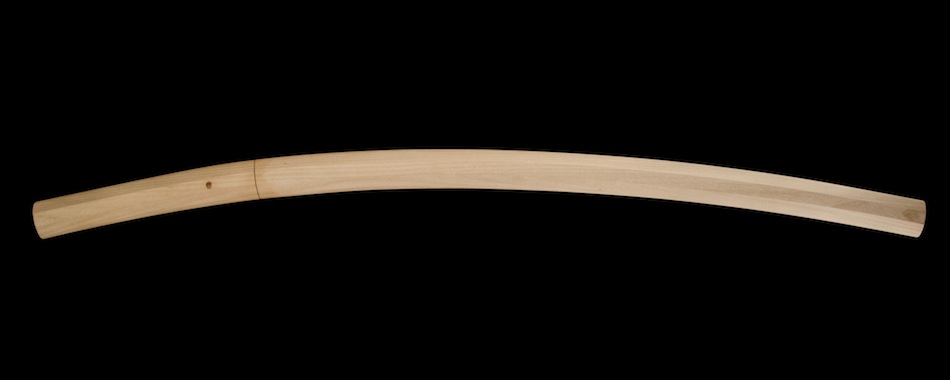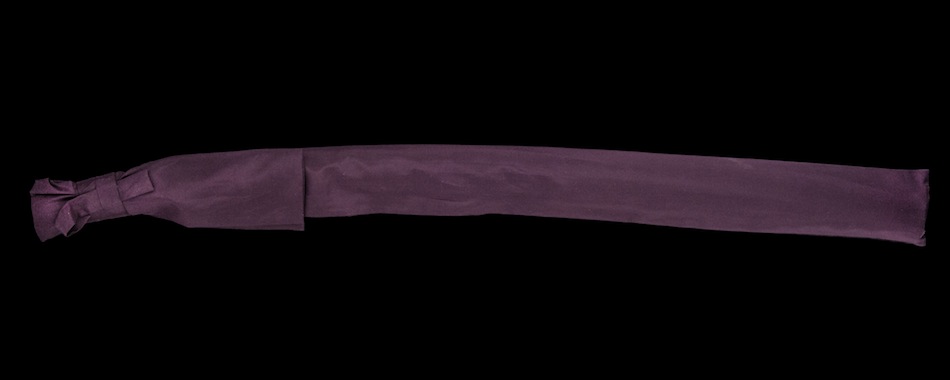A KANEZUMI KATANA
Overview
Kanezumi was a quality swordsmith of from the Nara school in the Mino tradition who had a reputation for making very sharp swords.
The first generation Kanezumi was the son of the infamous Kanesada – one of the representatives of the Mino tradition of sword making during the Muromachi period, circa Bunan era: (1444~1449). His name at birth was Jurozaemon.
This katana, crafted circa 1573-1592, carries a bold and wavy gunome midare hamon (temper line) with depictions of mountains and fishtails or arrow notches known as yahazuba.
The beautiful jihada (body of the sword) is a tightly forged itame (wood grain) with nagare (running) qualities. This sword has been recently polished by a respected polisher in the Kamakura area of Tokyo.
The katana is secured in a unique Uchigatana Tensho Koshirae produced with fittings from the Late Edo Period. This dark, elegant, and formal style of koshirae was first seen in the Tensho period (1573-1592).
Note how the tsuka (hilt) is shaped like an hourglass, with black-lacquered samekawa (ray skin) and wrapped in black leather. Even the antique copper habaki is coated with shakudo (a high-quality Japanese alloy comprising of about 96% copper and 4% gold).
The iron tsuba (guard) has details of bamboo trees, which is symbolic for health and a long life.
The fuchi (collar) carries the paulownia kamon (crest) of Hideyoshi Toyotomi – a Daimyo (great family), warrior, general and politician of the Sengoku period. He was one of the three unifiers of Japan, succeeding Oda Nobunaga in the Late Muromachi Period.
This sword was sold to a private collector in Germany.
Photos with detailed descriptions are below following the German translation.
Photos with detailed descriptions are below following the German translation.
Signiert, späte Muromachi Zeit (um 1570)
Schmied: KANEZUMI
Ort: Mino Provinz (heutige Gifu Präfektur)
Klinge: 67,3cm
Sori (Krümmung): 2,1cm
Jihada: Itame und Nagare Masame
Hamon: Gunome Midare und Togariba
Nagako: Ubu (ungekürzt / unverändert)
Zertifikat: NTHK-NPO Kanteisho (als „Wichtig“ klassifizierte Klinge, vergeben von der Gesellschaft zur Erhaltung des Japanischen Schwerts)
Kanezumi war ein qualitativ guter Schmied der Nara-Schule und hat in der Mino Tradition gearbeitet. Die Klingen gelten als „wazamono“, d.h. „scharf“.
In der 1. Generation war Kanezumi der Sohn des berühmt-berüchtigten Kanesada – einer der Mino-Schmiede, die in der Muromachi Zeit, Bunan Ära ca. 1444 – 1449 tätig waren. Sein Geburtsname war Jurozaemon.
Dieses Katana wurde ca. 1573 – 1592 geschmiedet und besitzt ein sehr prägnantes und geschwungenes gunome midare Hamon (Härtelinie) mit Ausprägungen von Bergen und Fischschwänzen bzw. Pfeilspitzen, bekannt als „yahazuba“.
Der hochwertige Klingenkörper („jihada“) besteht aus eng geschmiedetem „itame“ (ähnelt einer Holzsstruktur) mit „nagare“ (fließenden) Qualitäten.
Alle wichtigen Elemente der Koshirae stammen aus der späten Edo-Zeit (19. Jahrhundert) in einer eher seltenen, originalen Uchigatana Tensho-Montierung. Diese Art der schlichten, formalen und eleganten Montierung fand seinen Ursprung in der Tensho Zeit (ca. 1573 – 1592). Merkmale sind die Uhrglasform des Griffes („tsuka“), die schwarze Griffunterwicklung („samekawa“) aus Rochenhaut sowie die schwarze Lederwicklung („tsuka-ito“). Ebenso interessant ist das antike kupferne „habaki“ mit schöner Patina.
Die Tsuba (Stichblatt) beinhaltet Details von Bambusbäumen; diese symbolisieren Gesundheit und ein langes Leben.
Das Fuchi trägt das Kamon (Wappen) von Hideyoshi Toyotomi – aus einer Daimyo Familie stammender berühmter Krieger, General und Politiker aus der Genroku-Era. Er war einer der 3 großen Zusammenführer Japans und Nachfolger von Oda Nobunaga in der späten Muromachi Zeit.
*Photos by Eric Bossick for Unique Japan
Interested in Ownership of an Antique Japanese Sword?
If owning an authentic Japanese Samurai sword is of interest to you and your family, we would be honoured to serve you.
To visitors in Japan…
If you have the pleasure of living in Japan or visiting the country, we recommend that you come to one of our upcoming sword shows or schedule a private VIP meeting with us.
VIP meetings are normally held near JR Ebisu station in Tokyo at a hired gallery space. We can also arrange visits to a company office, hotel, near the airport or at a private residence.
To visitors around the world…
To those exploring our collection online, be sure to download our catalogue of available swords here.
We completely respect the fact it takes a HUGE leap of personal FAITH in us to commit to a particular sword given the reliance on photos and descriptions for such a highly valued item.
It is our PROMISE to address all your questions to the best of our ability. It’s important to us that you feel completely confident that the sword you choose (and that chooses you) is destined for you and your family.
You can also take reassurance that ALL swords from Unique Japan are GUARANTEED AUTHENTIC and come with a 3-DAY WORRY FREE inspection period upon arrival to your home.
Legal Exportation from Japan
Yes, it is completely legal to own a genuine antique Japanese sword (even those that are several hundreds of years old). Unique Japan specialises in all proper legal compliances so that swords can be exported from Japan.
All required paperwork is provided free of charge for clients.
All required paperwork is provided free of charge for clients.
Unique Japan has safely sent well over 150 swords FROM Japan to immensely proud owners in the United States, Canada, Europe and around the world.
We look forward to making your dream of owning an authentic Japanese sword a reality for you.
Popular Pages of Interest
→ 7 Points to Consider when Choosing your Japanese Sword
→ 5 Steps to Owning an Authentic Japanese Samurai Sword
→ Download catalogue of currently available Japanese swords
→ PARTS of a Japanese Sword and Mountings (High-quality images)
→ 7 reasons WHY I love Japanese swords
→ Resource Information on Japanese Swords
→ NBTHK Certification Paper Ranking for Japanese Swords
→ NTHK-NPO Certification Paper Ranking for Japanese Swords
→ 5 Steps to Owning an Authentic Japanese Samurai Sword
→ Download catalogue of currently available Japanese swords
→ PARTS of a Japanese Sword and Mountings (High-quality images)
→ 7 reasons WHY I love Japanese swords
→ Resource Information on Japanese Swords
→ NBTHK Certification Paper Ranking for Japanese Swords
→ NTHK-NPO Certification Paper Ranking for Japanese Swords



